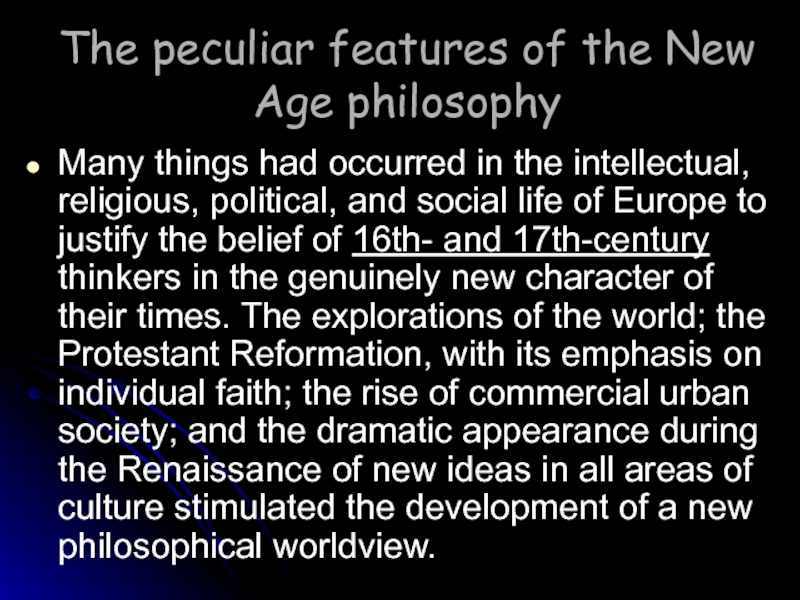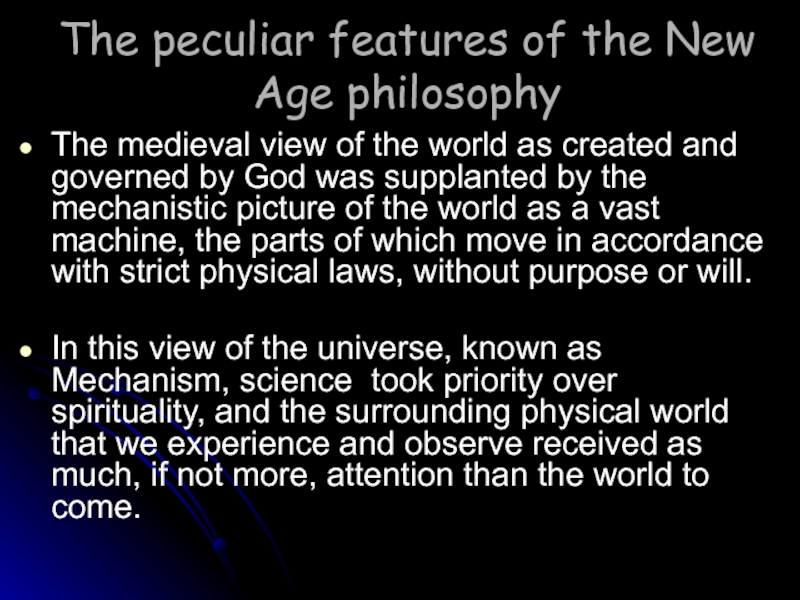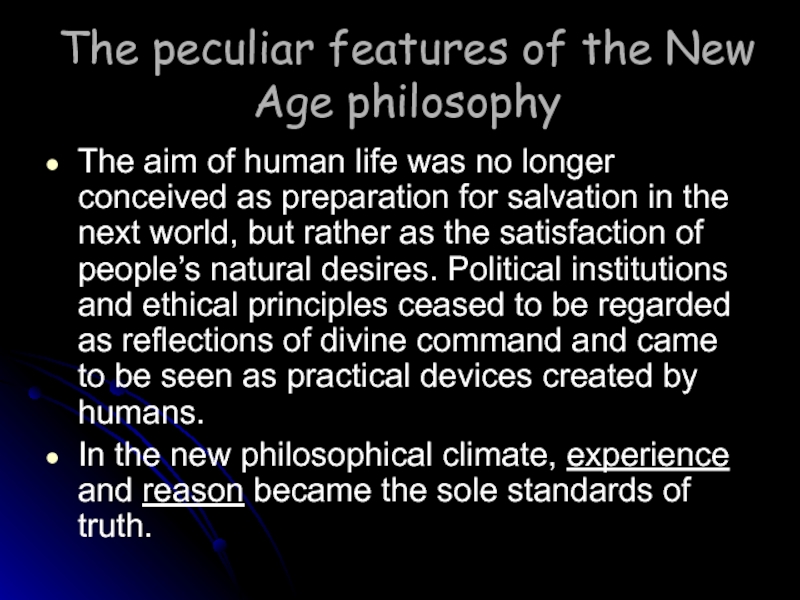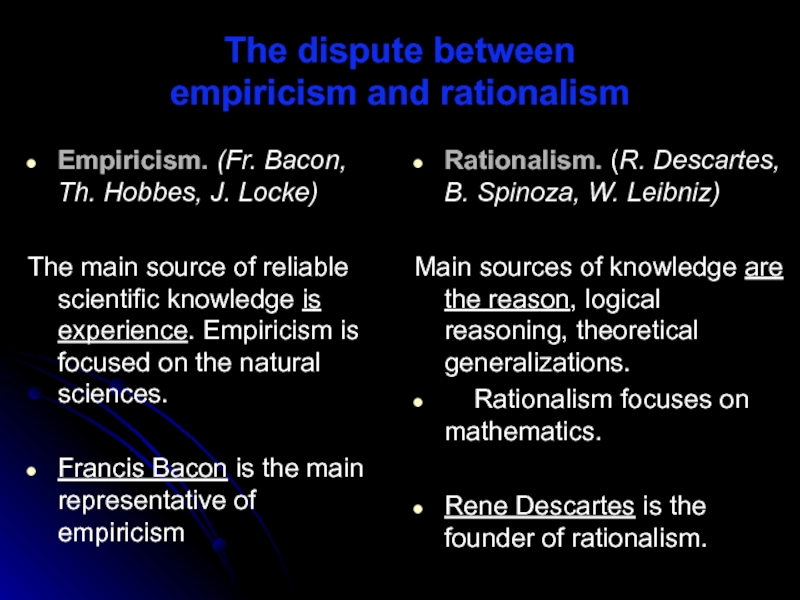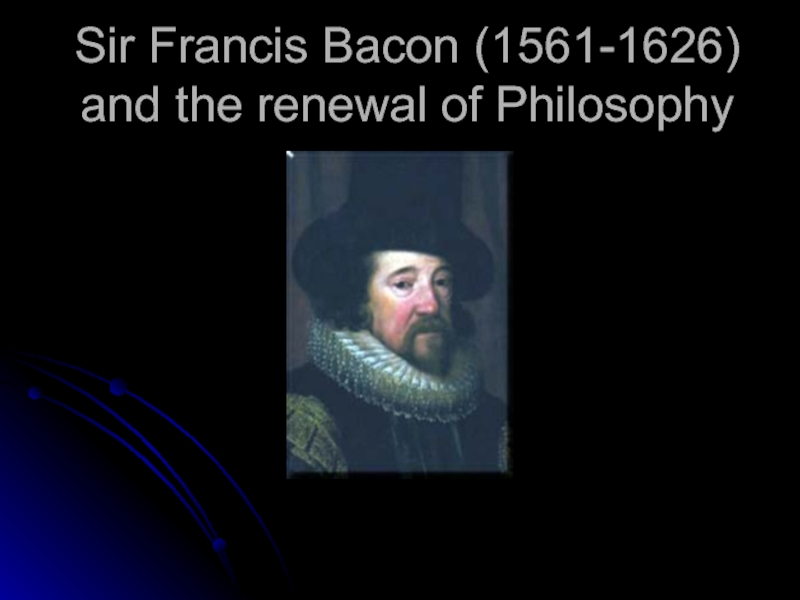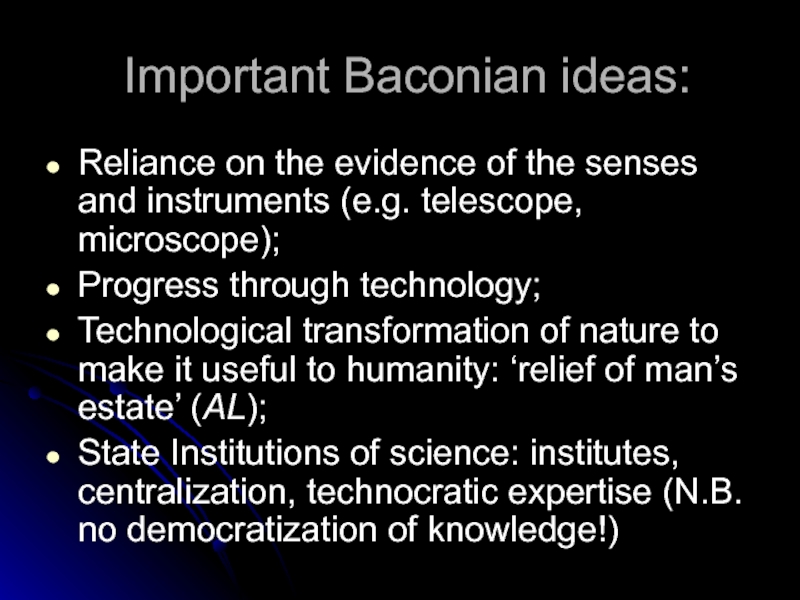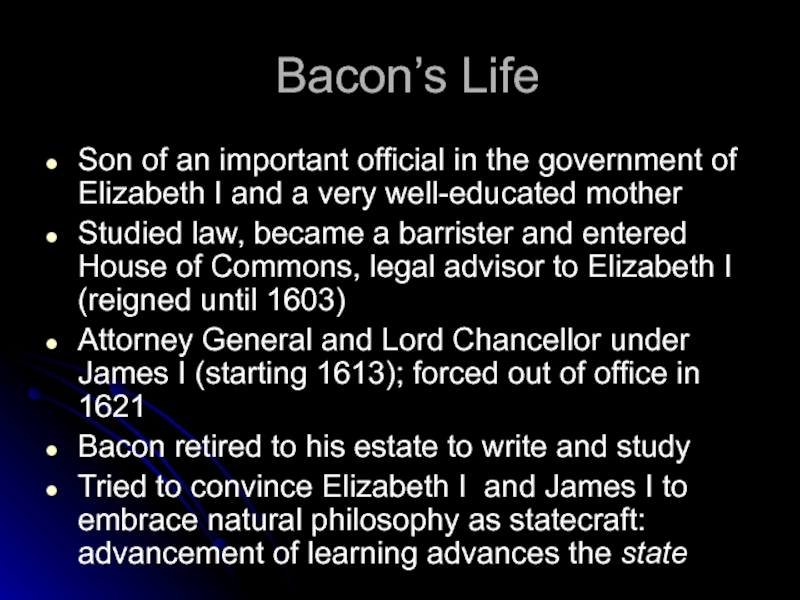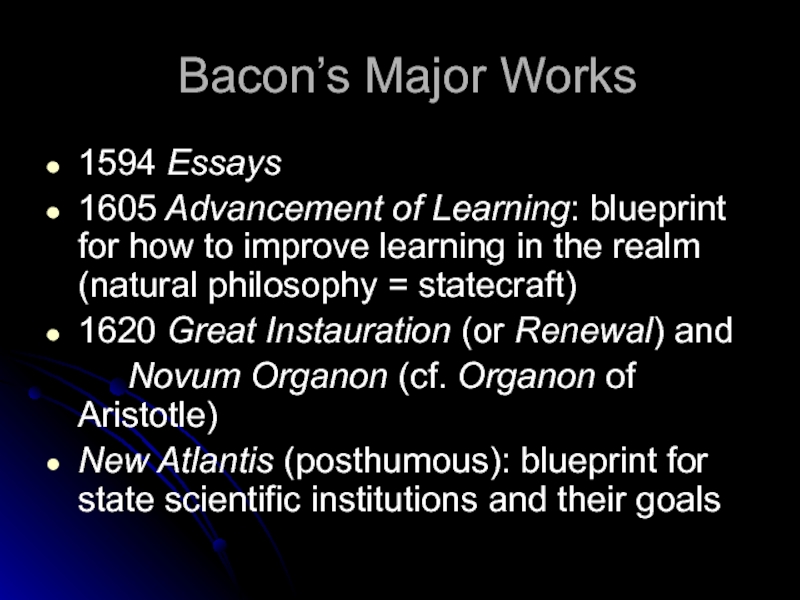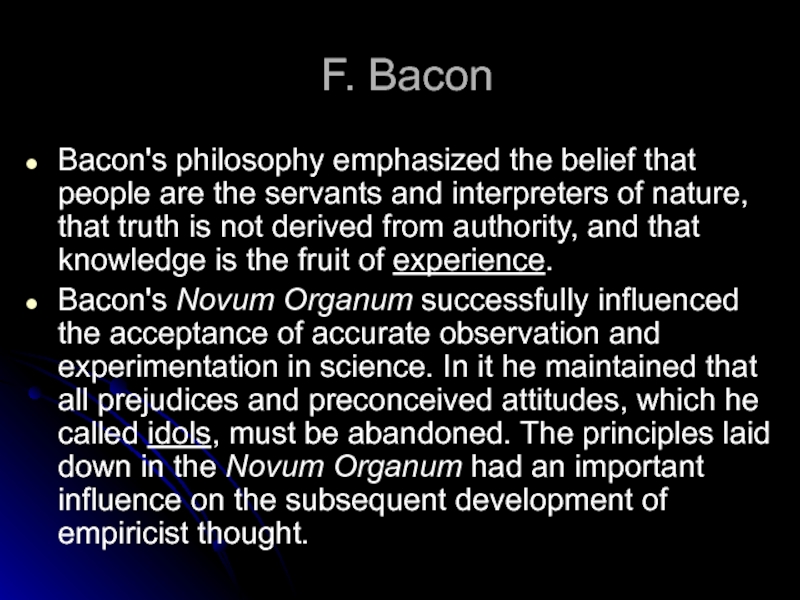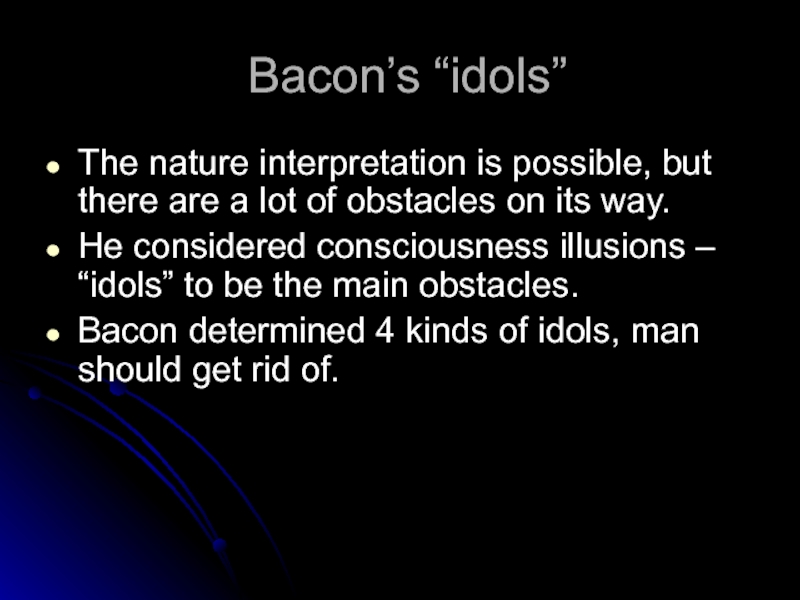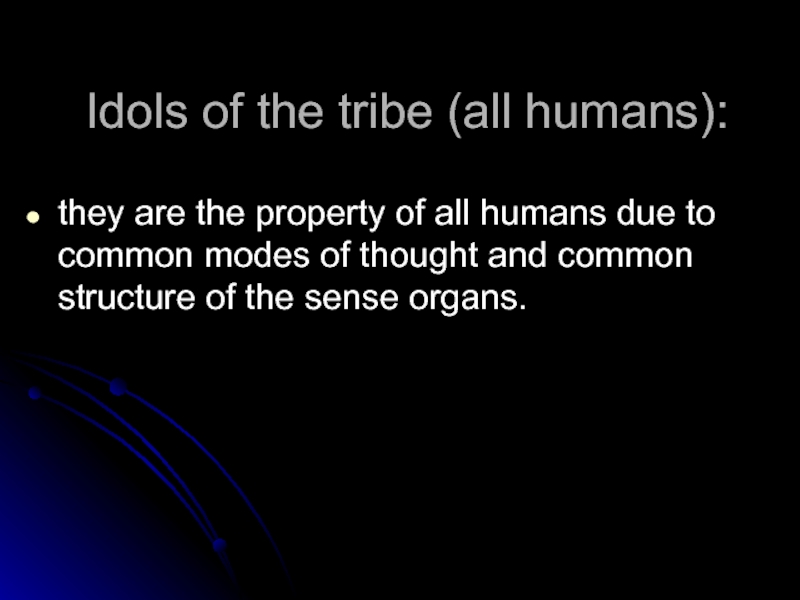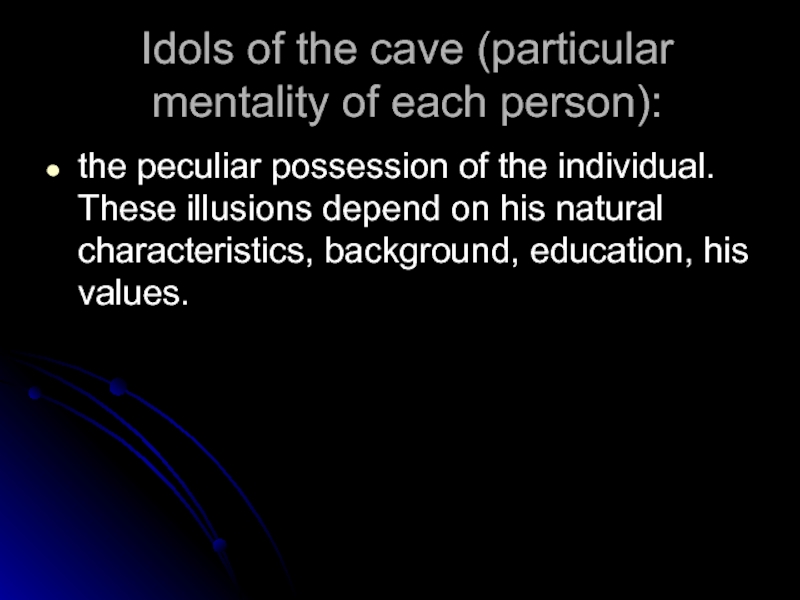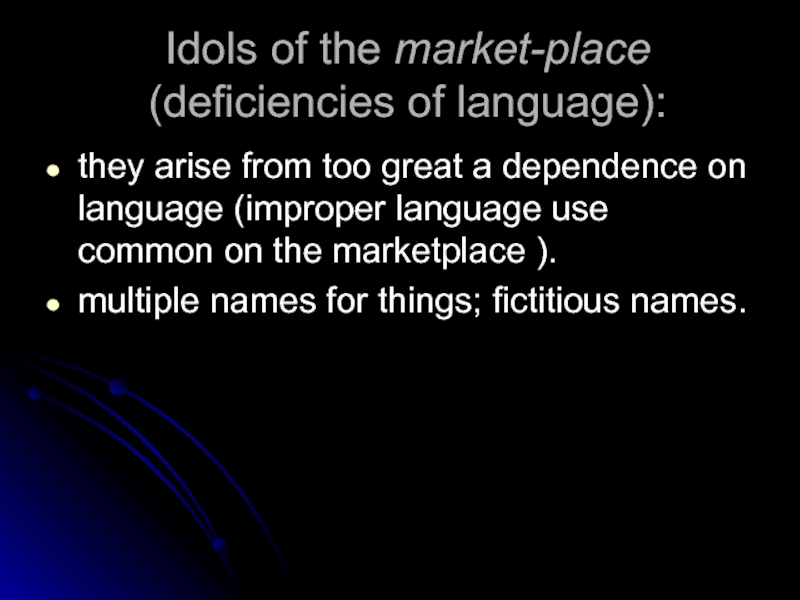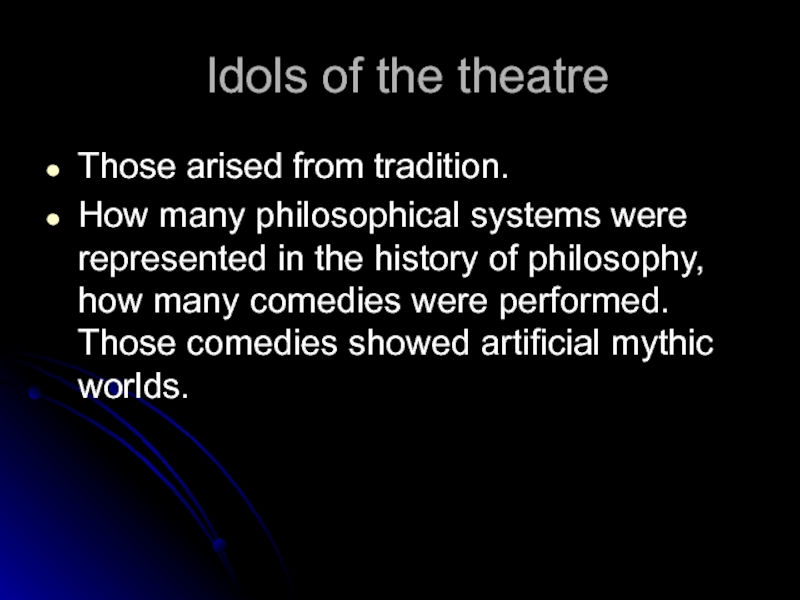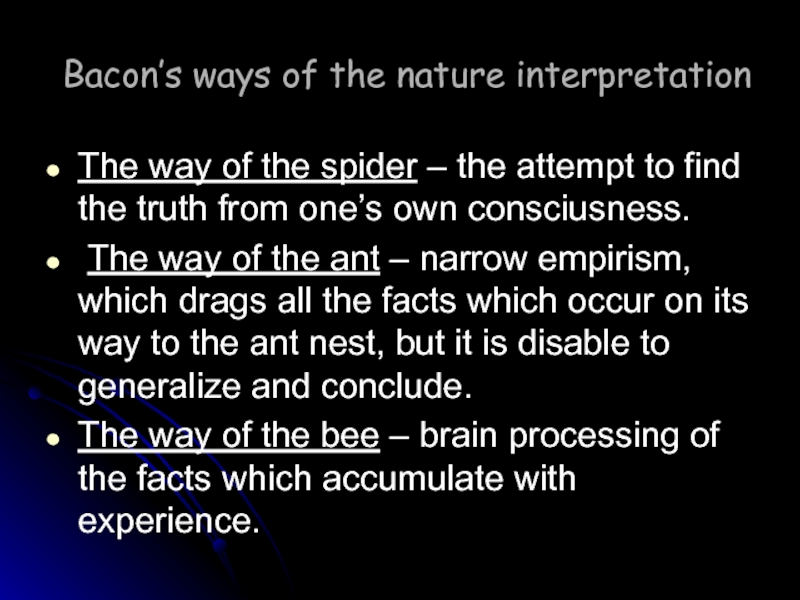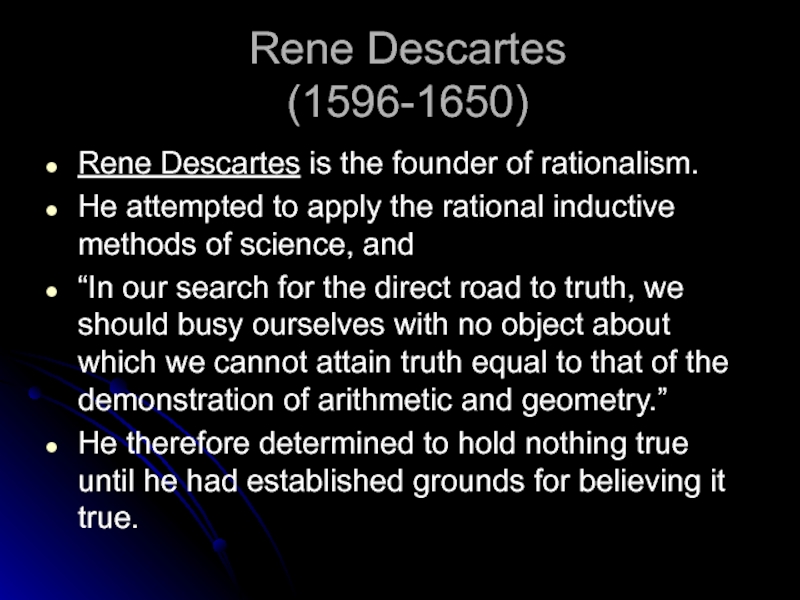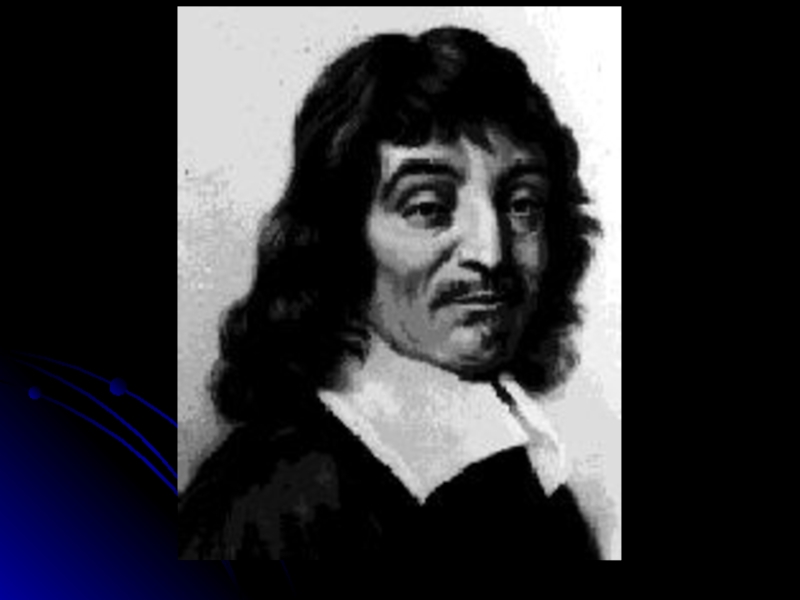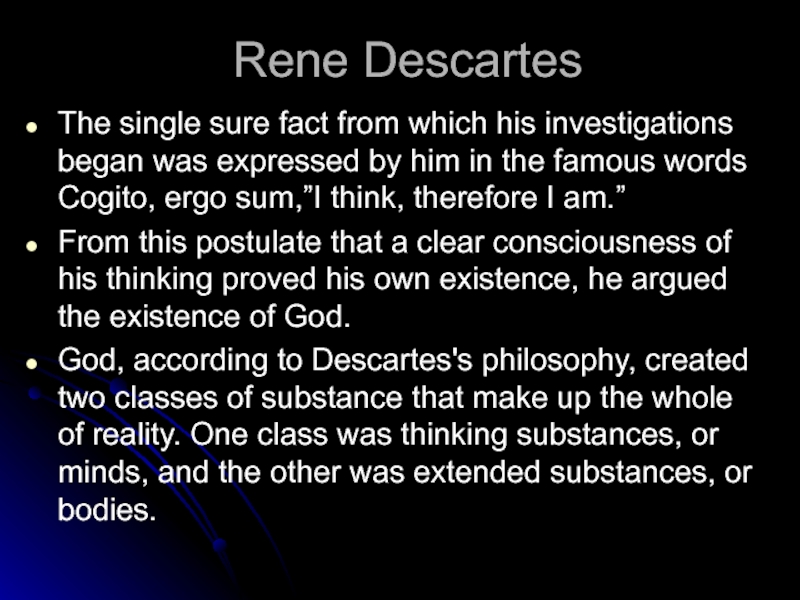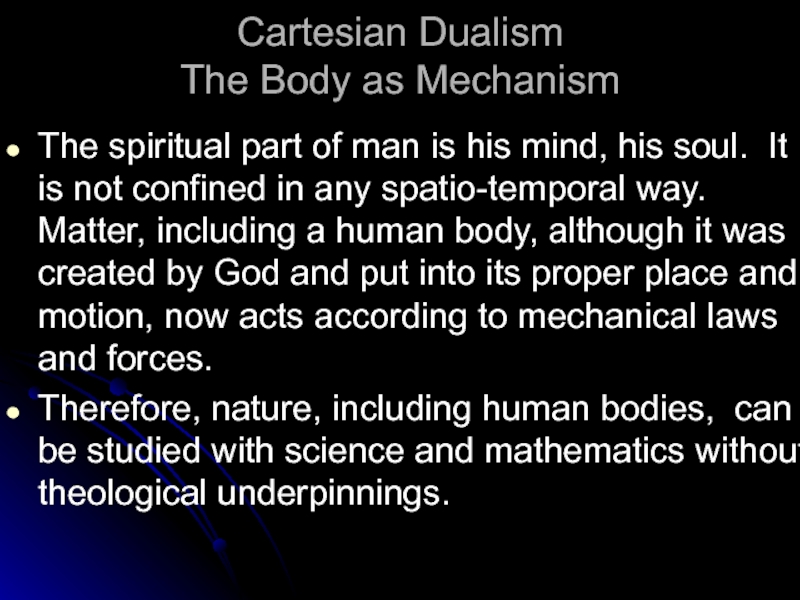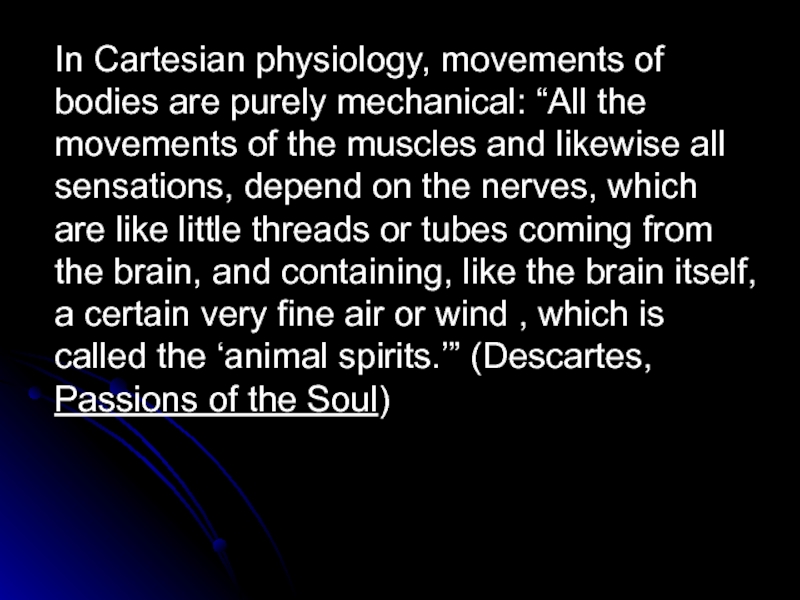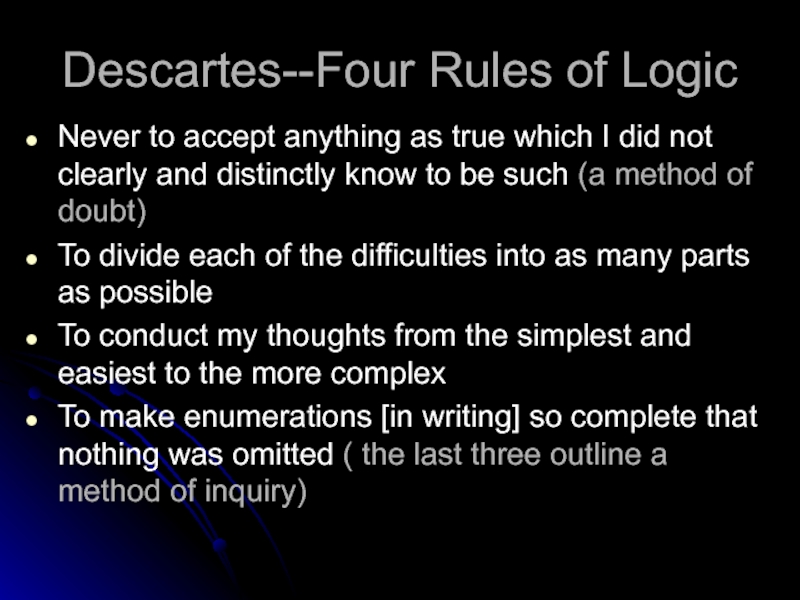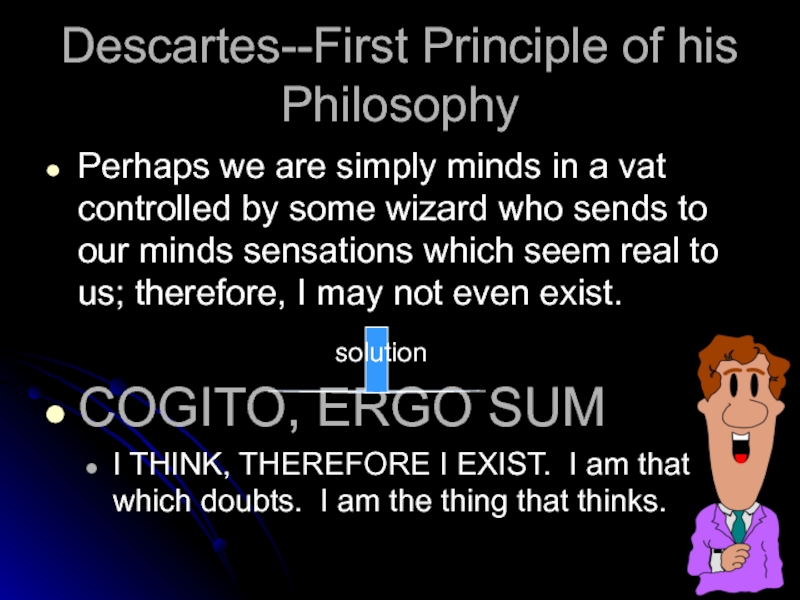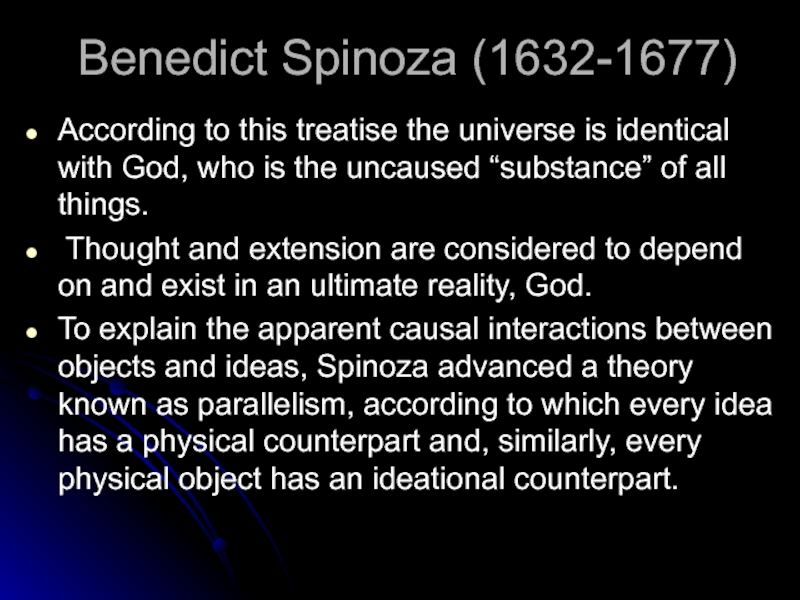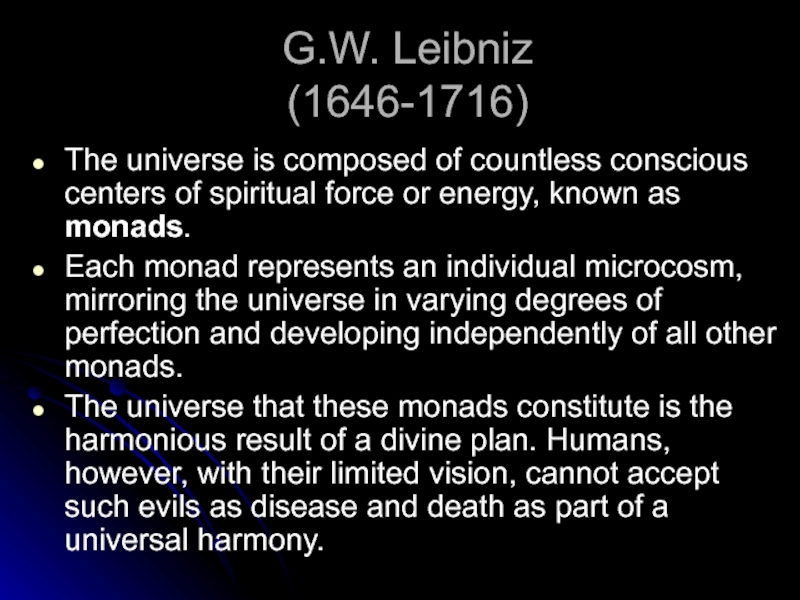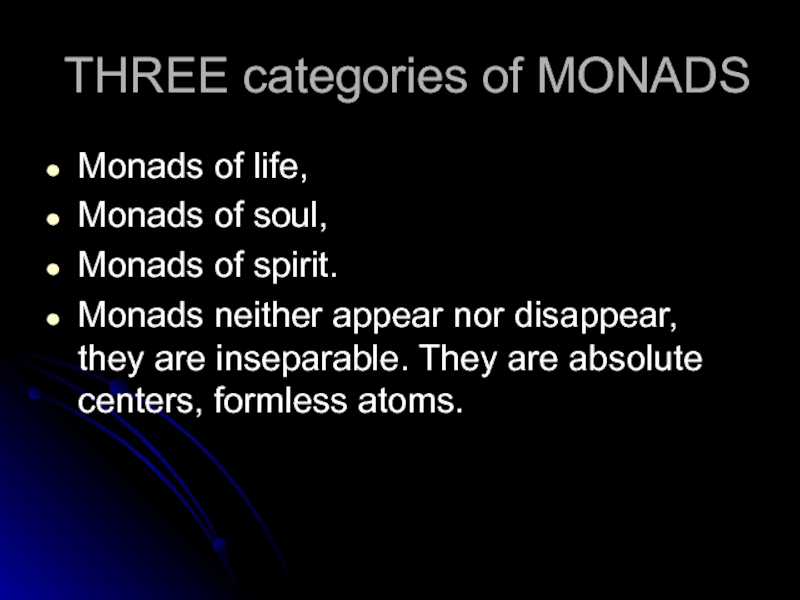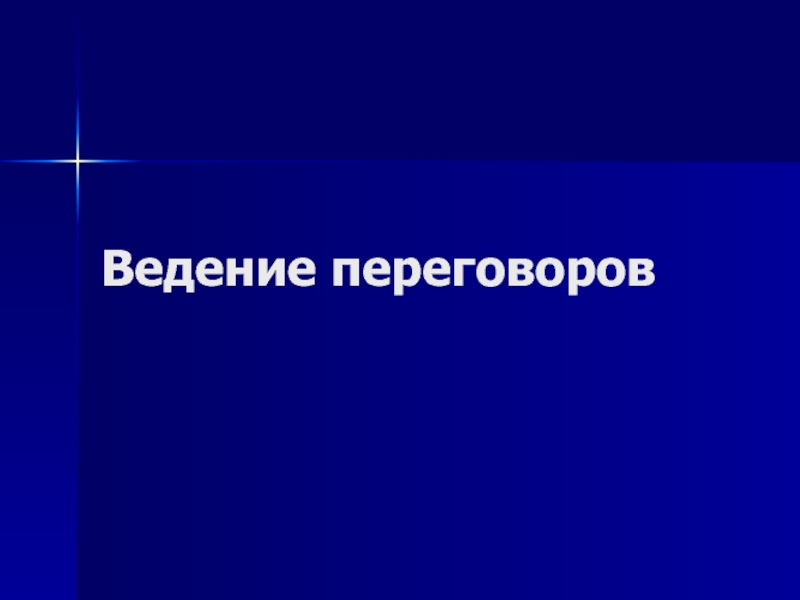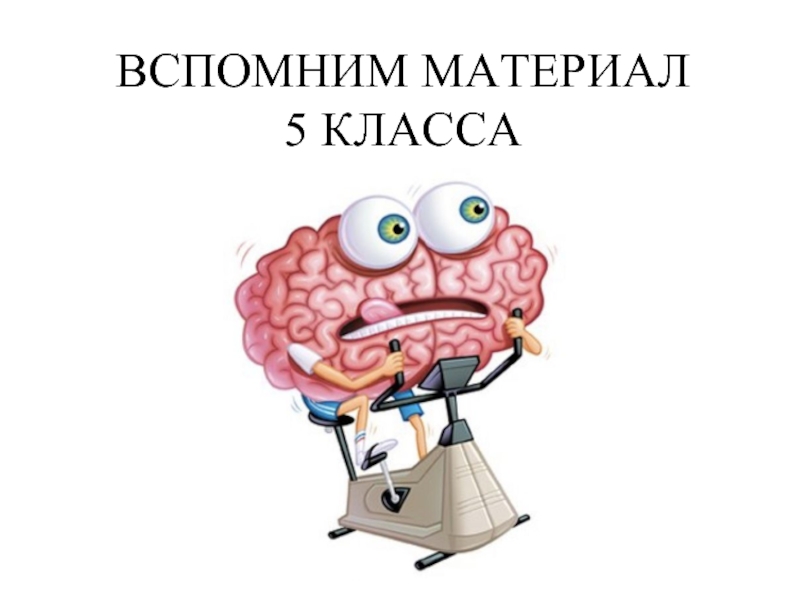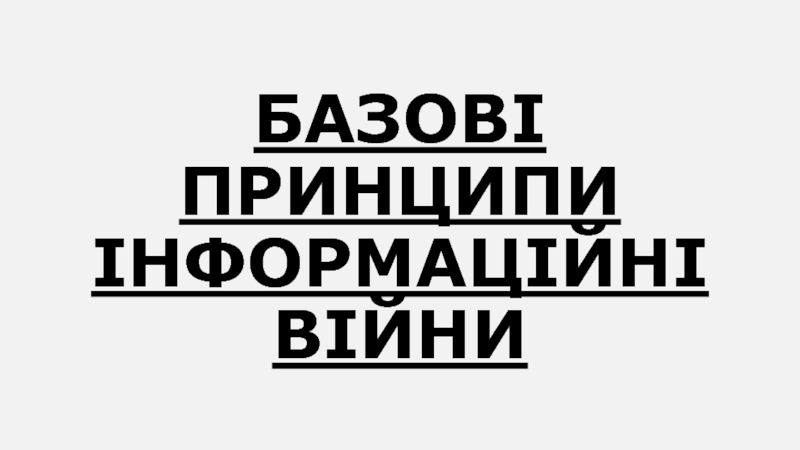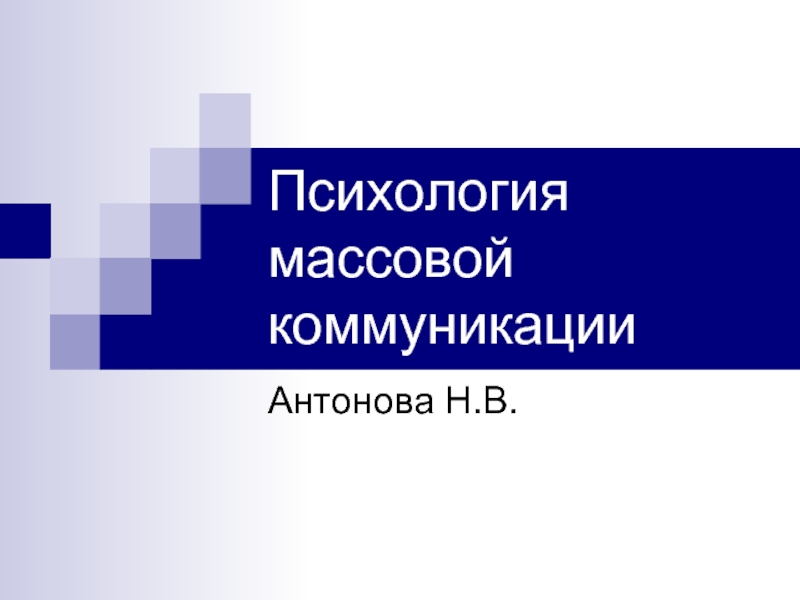philosophy.
The Empiricism. F. Bacon’s philosophy
The Rationalism. The philosophy of R. Descartes, B. Spinoza, G. Leibniz
- Главная
- Разное
- Дизайн
- Бизнес и предпринимательство
- Аналитика
- Образование
- Развлечения
- Красота и здоровье
- Финансы
- Государство
- Путешествия
- Спорт
- Недвижимость
- Армия
- Графика
- Культурология
- Еда и кулинария
- Лингвистика
- Английский язык
- Астрономия
- Алгебра
- Биология
- География
- Детские презентации
- Информатика
- История
- Литература
- Маркетинг
- Математика
- Медицина
- Менеджмент
- Музыка
- МХК
- Немецкий язык
- ОБЖ
- Обществознание
- Окружающий мир
- Педагогика
- Русский язык
- Технология
- Физика
- Философия
- Химия
- Шаблоны, картинки для презентаций
- Экология
- Экономика
- Юриспруденция
Philosophy of the New Age (17th-century) презентация
Содержание
- 1. Philosophy of the New Age (17th-century)
- 2. The peculiar features of the New Age
- 3. The peculiar features of the New Age
- 4. The peculiar features of the New Age
- 5. The dispute between empiricism and rationalism
- 6. Sir Francis Bacon (1561-1626) and the renewal of Philosophy
- 7. Important Baconian ideas: Reliance on the evidence
- 8. Bacon’s Life Son of an important official
- 9. Bacon’s Major Works 1594 Essays 1605 Advancement
- 10. F. Bacon Bacon's philosophy emphasized the belief that
- 11. Bacon’s “idols” The nature interpretation is possible,
- 12. Idols of the tribe (all humans):
- 13. Idols of the cave (particular mentality of
- 14. Idols of the market-place (deficiencies of language):
- 15. Idols of the theatre Those arised from
- 16. Bacon’s ways of the nature interpretation The
- 17. Rene Descartes (1596-1650) Rene Descartes
- 19. Rene Descartes The single sure fact from
- 20. Cartesian Dualism The Body as Mechanism The
- 21. In Cartesian physiology, movements of bodies are
- 22. Descartes--Four Rules of Logic Never to accept
- 23. Descartes--First Principle of his Philosophy Perhaps we
- 24. Benedict Spinoza (1632-1677) According to this treatise
- 25. G.W. Leibniz (1646-1716) The universe
- 26. THREE categories of MONADS Monads of life,
Слайд 2The peculiar features of the New Age philosophy
Many things had
occurred in the intellectual, religious, political, and social life of Europe to justify the belief of 16th- and 17th-century thinkers in the genuinely new character of their times. The explorations of the world; the Protestant Reformation, with its emphasis on individual faith; the rise of commercial urban society; and the dramatic appearance during the Renaissance of new ideas in all areas of culture stimulated the development of a new philosophical worldview.
Слайд 3The peculiar features of the New Age philosophy
The medieval view of
the world as created and governed by God was supplanted by the mechanistic picture of the world as a vast machine, the parts of which move in accordance with strict physical laws, without purpose or will.
In this view of the universe, known as Mechanism, science took priority over spirituality, and the surrounding physical world that we experience and observe received as much, if not more, attention than the world to come.
In this view of the universe, known as Mechanism, science took priority over spirituality, and the surrounding physical world that we experience and observe received as much, if not more, attention than the world to come.
Слайд 4The peculiar features of the New Age philosophy
The aim of human
life was no longer conceived as preparation for salvation in the next world, but rather as the satisfaction of people’s natural desires. Political institutions and ethical principles ceased to be regarded as reflections of divine command and came to be seen as practical devices created by humans.
In the new philosophical climate, experience and reason became the sole standards of truth.
In the new philosophical climate, experience and reason became the sole standards of truth.
Слайд 5The dispute between
empiricism and rationalism
Empiricism. (Fr. Bacon, Th. Hobbes, J.
Locke)
The main source of reliable scientific knowledge is experience. Empiricism is focused on the natural sciences.
Francis Bacon is the main representative of empiricism
The main source of reliable scientific knowledge is experience. Empiricism is focused on the natural sciences.
Francis Bacon is the main representative of empiricism
Rationalism. (R. Descartes, B. Spinoza, W. Leibniz)
Main sources of knowledge are the reason, logical reasoning, theoretical generalizations.
Rationalism focuses on mathematics.
Rene Descartes is the founder of rationalism.
Слайд 7Important Baconian ideas:
Reliance on the evidence of the senses and instruments
(e.g. telescope, microscope);
Progress through technology;
Technological transformation of nature to make it useful to humanity: ‘relief of man’s estate’ (AL);
State Institutions of science: institutes, centralization, technocratic expertise (N.B. no democratization of knowledge!)
Progress through technology;
Technological transformation of nature to make it useful to humanity: ‘relief of man’s estate’ (AL);
State Institutions of science: institutes, centralization, technocratic expertise (N.B. no democratization of knowledge!)
Слайд 8Bacon’s Life
Son of an important official in the government of Elizabeth
I and a very well-educated mother
Studied law, became a barrister and entered House of Commons, legal advisor to Elizabeth I (reigned until 1603)
Attorney General and Lord Chancellor under James I (starting 1613); forced out of office in 1621
Bacon retired to his estate to write and study
Tried to convince Elizabeth I and James I to embrace natural philosophy as statecraft: advancement of learning advances the state
Studied law, became a barrister and entered House of Commons, legal advisor to Elizabeth I (reigned until 1603)
Attorney General and Lord Chancellor under James I (starting 1613); forced out of office in 1621
Bacon retired to his estate to write and study
Tried to convince Elizabeth I and James I to embrace natural philosophy as statecraft: advancement of learning advances the state
Слайд 9Bacon’s Major Works
1594 Essays
1605 Advancement of Learning: blueprint for how to
improve learning in the realm (natural philosophy = statecraft)
1620 Great Instauration (or Renewal) and
Novum Organon (cf. Organon of Aristotle)
New Atlantis (posthumous): blueprint for state scientific institutions and their goals
1620 Great Instauration (or Renewal) and
Novum Organon (cf. Organon of Aristotle)
New Atlantis (posthumous): blueprint for state scientific institutions and their goals
Слайд 10F. Bacon
Bacon's philosophy emphasized the belief that people are the servants and
interpreters of nature, that truth is not derived from authority, and that knowledge is the fruit of experience.
Bacon's Novum Organum successfully influenced the acceptance of accurate observation and experimentation in science. In it he maintained that all prejudices and preconceived attitudes, which he called idols, must be abandoned. The principles laid down in the Novum Organum had an important influence on the subsequent development of empiricist thought.
Bacon's Novum Organum successfully influenced the acceptance of accurate observation and experimentation in science. In it he maintained that all prejudices and preconceived attitudes, which he called idols, must be abandoned. The principles laid down in the Novum Organum had an important influence on the subsequent development of empiricist thought.
Слайд 11Bacon’s “idols”
The nature interpretation is possible, but there are a lot
of obstacles on its way.
He considered consciousness illusions – “idols” to be the main obstacles.
Bacon determined 4 kinds of idols, man should get rid of.
He considered consciousness illusions – “idols” to be the main obstacles.
Bacon determined 4 kinds of idols, man should get rid of.
Слайд 12Idols of the tribe (all humans):
they are the property of
all humans due to common modes of thought and common structure of the sense organs.
Слайд 13Idols of the cave (particular mentality of each person):
the peculiar
possession of the individual. These illusions depend on his natural characteristics, background, education, his values.
Слайд 14Idols of the market-place (deficiencies of language):
they arise from too
great a dependence on language (improper language use common on the marketplace ).
multiple names for things; fictitious names.
multiple names for things; fictitious names.
Слайд 15Idols of the theatre
Those arised from tradition.
How many philosophical systems were
represented in the history of philosophy, how many comedies were performed. Those comedies showed artificial mythic worlds.
Слайд 16Bacon’s ways of the nature interpretation
The way of the spider –
the attempt to find the truth from one’s own consciusness.
The way of the ant – narrow empirism, which drags all the facts which occur on its way to the ant nest, but it is disable to generalize and conclude.
The way of the bee – brain processing of the facts which accumulate with experience.
The way of the ant – narrow empirism, which drags all the facts which occur on its way to the ant nest, but it is disable to generalize and conclude.
The way of the bee – brain processing of the facts which accumulate with experience.
Слайд 17Rene Descartes
(1596-1650)
Rene Descartes is the founder of rationalism.
He attempted
to apply the rational inductive methods of science, and
“In our search for the direct road to truth, we should busy ourselves with no object about which we cannot attain truth equal to that of the demonstration of arithmetic and geometry.”
He therefore determined to hold nothing true until he had established grounds for believing it true.
“In our search for the direct road to truth, we should busy ourselves with no object about which we cannot attain truth equal to that of the demonstration of arithmetic and geometry.”
He therefore determined to hold nothing true until he had established grounds for believing it true.
Слайд 19Rene Descartes
The single sure fact from which his investigations began was
expressed by him in the famous words Cogito, ergo sum,”I think, therefore I am.”
From this postulate that a clear consciousness of his thinking proved his own existence, he argued the existence of God.
God, according to Descartes's philosophy, created two classes of substance that make up the whole of reality. One class was thinking substances, or minds, and the other was extended substances, or bodies.
From this postulate that a clear consciousness of his thinking proved his own existence, he argued the existence of God.
God, according to Descartes's philosophy, created two classes of substance that make up the whole of reality. One class was thinking substances, or minds, and the other was extended substances, or bodies.
Слайд 20Cartesian Dualism
The Body as Mechanism
The spiritual part of man is his
mind, his soul. It is not confined in any spatio-temporal way. Matter, including a human body, although it was created by God and put into its proper place and motion, now acts according to mechanical laws and forces.
Therefore, nature, including human bodies, can be studied with science and mathematics without theological underpinnings.
Therefore, nature, including human bodies, can be studied with science and mathematics without theological underpinnings.
Слайд 21In Cartesian physiology, movements of bodies are purely mechanical: “All the
movements of the muscles and likewise all sensations, depend on the nerves, which are like little threads or tubes coming from the brain, and containing, like the brain itself, a certain very fine air or wind , which is called the ‘animal spirits.’” (Descartes, Passions of the Soul)
Слайд 22Descartes--Four Rules of Logic
Never to accept anything as true which I
did not clearly and distinctly know to be such (a method of doubt)
To divide each of the difficulties into as many parts as possible
To conduct my thoughts from the simplest and easiest to the more complex
To make enumerations [in writing] so complete that nothing was omitted ( the last three outline a method of inquiry)
To divide each of the difficulties into as many parts as possible
To conduct my thoughts from the simplest and easiest to the more complex
To make enumerations [in writing] so complete that nothing was omitted ( the last three outline a method of inquiry)
Слайд 23Descartes--First Principle of his Philosophy
Perhaps we are simply minds in a
vat controlled by some wizard who sends to our minds sensations which seem real to us; therefore, I may not even exist.
COGITO, ERGO SUM
I THINK, THEREFORE I EXIST. I am that which doubts. I am the thing that thinks.
COGITO, ERGO SUM
I THINK, THEREFORE I EXIST. I am that which doubts. I am the thing that thinks.
Слайд 24Benedict Spinoza (1632-1677)
According to this treatise the universe is identical with
God, who is the uncaused “substance” of all things.
Thought and extension are considered to depend on and exist in an ultimate reality, God.
To explain the apparent causal interactions between objects and ideas, Spinoza advanced a theory known as parallelism, according to which every idea has a physical counterpart and, similarly, every physical object has an ideational counterpart.
Thought and extension are considered to depend on and exist in an ultimate reality, God.
To explain the apparent causal interactions between objects and ideas, Spinoza advanced a theory known as parallelism, according to which every idea has a physical counterpart and, similarly, every physical object has an ideational counterpart.
Слайд 25G.W. Leibniz
(1646-1716)
The universe is composed of countless conscious centers
of spiritual force or energy, known as monads.
Each monad represents an individual microcosm, mirroring the universe in varying degrees of perfection and developing independently of all other monads.
The universe that these monads constitute is the harmonious result of a divine plan. Humans, however, with their limited vision, cannot accept such evils as disease and death as part of a universal harmony.
Each monad represents an individual microcosm, mirroring the universe in varying degrees of perfection and developing independently of all other monads.
The universe that these monads constitute is the harmonious result of a divine plan. Humans, however, with their limited vision, cannot accept such evils as disease and death as part of a universal harmony.
Слайд 26THREE categories of MONADS
Monads of life,
Monads of soul,
Monads of spirit.
Monads neither appear nor disappear, they are inseparable. They are absolute centers, formless atoms.

